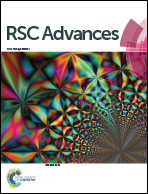Study to explore assorted interfaces of an ionic liquid prevailing in solvent systems by physicochemical approach
Abstract
The electrolytic conductivities, densities, viscosities, refractive indices and FT-IR studies of 1-butyl-pyridinium bromide ([bupy]Br) have been studied in 1,4 dioxane, tetrahydrofuran, and acetonitrile at different temperatures. The molar conductivities observed were explained with the manifestation of the formation of ion-pairs and triple ion formation. The limiting ionic conductances have been estimated from the appropriate division of limiting the molar conductance of tetrabutylammonium tetraphenylborate as “reference electrolyte” method, along with a numerical evaluation of ion-pair and triple-ion formation constants (KP ≈ KA and KT). Ion–solvent interactions have been interpreted in terms of apparent molar volumes, viscosity B-coefficients and molar refraction, which are obtained from the results supplemented with densities, viscosities and refractive index respectively. The FT-IR spectra of the solvents as well as the solutions have also been studied. The results have been discussed in terms of ion–dipole interactions, structural aspects and configurational theory.


 Please wait while we load your content...
Please wait while we load your content...